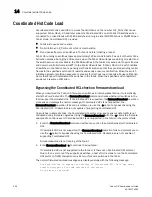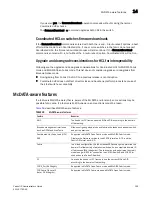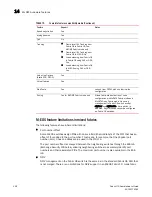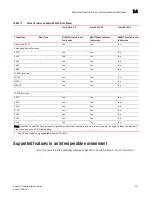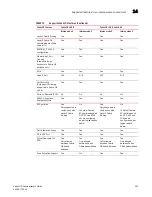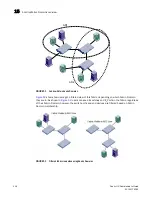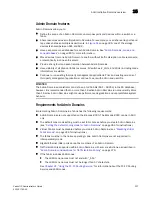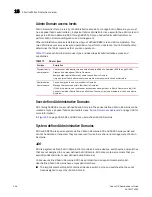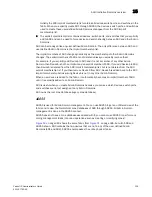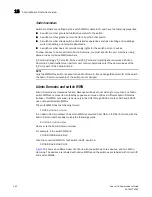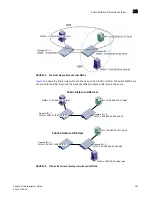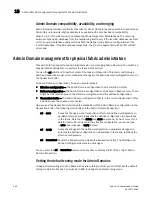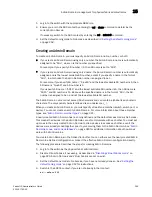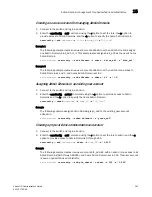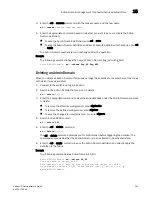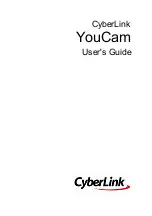
Fabric OS Administrator’s Guide
337
53-1001763-02
Administrative Domains overview
15
Admin Domain features
Admin Domains allow you to:
•
Define the scope of an Admin Domain to encompass ports and devices within a switch or a
fabric.
•
Share resources across multiple Admin Domains. For example, you can share array ports and
tape drives between multiple departments. In
Figure 51
on page 336, one of the storage
devices is shared between AD1 and AD2.
•
Have a separate zone database for each Admin Domain. See
“Admin Domains, zones, and
zone databases”
on page 360 for more information.
•
Move devices from one Admin Domain to another without traffic disruption, cable reconnects,
or discontinuity in zone enforcement.
•
Provide strong fault and event isolation between Admin Domains.
•
Have visibility of all physical fabric resources. All switches, E_Ports, and FRUs (including blade
information) are visible.
•
Continue to run existing third-party management applications. Prior and existing versions of
third party management applications continue to work with admin and user IDs.
ATTENTION
The Admin Domain administrator can define up to 254 ADs (AD1 – AD254) in the AD database;
however, it is recommended that no more than 16 active Admin Domains run concurrently. More
than 16 active Admin Domains might cause performance degradation and unpredictable system
behavior.
Requirements for Admin Domains
Implementing Admin Domains in a fabric has the following requirements:
•
Admin Domains are not supported on the Brocade 8000. The Brocade 8000 can be in AD0
only.
•
The default zone mode setting must be set to No Access before you create Admin Domains
(see
“Setting the default zoning mode for Admin Domains”
on page 344 for instructions).
•
Virtual Fabrics must be disabled before you create Admin Domains (see
“Disabling Virtual
Fabrics mode”
on page 224 for instructions).
•
The fabric must be in the native operating mode. Admin Domains are not supported in
interoperability mode.
•
Gigabit Ethernet (GbE) ports cannot be members of an Admin Domain.
•
Traffic Isolation is supported within Admin Domains, with some restrictions, as described in
“Admin Domain considerations for Traffic Isolation Zoning”
on page 279.
•
If the fabric includes LSAN zones:
-
The LSAN zone names must not end with “_AD
n
”.
-
The LSAN zone names must not be longer than 57 characters.
See
Chapter 21, “Using the FC-FC Routing Service,”
for information about the FC-FC Routing
Service and LSAN zones.
Summary of Contents for 53-1001763-02
Page 1: ...53 1001763 02 13 September 2010 Fabric OS Administrator s Guide Supporting Fabric OS v6 4 0 ...
Page 4: ...iv Fabric OS Administrator s Guide 53 1001763 02 ...
Page 24: ...xxiv Fabric OS Administrator s Guide 53 1001763 02 ...
Page 28: ...xxviii Fabric OS Administrator s Guide 53 1001763 02 ...
Page 32: ...xxxii Fabric OS Administrator s Guide 53 1001763 02 ...
Page 40: ...xl Fabric OS Administrator s Guide 53 1001763 02 ...
Page 42: ...2 Fabric OS Administrator s Guide 53 1001763 02 ...
Page 54: ...14 Fabric OS Administrator s Guide 53 1001763 02 High availability of daemon processes 1 ...
Page 74: ...34 Fabric OS Administrator s Guide 53 1001763 02 Basic connections 2 ...
Page 102: ...62 Fabric OS Administrator s Guide 53 1001763 02 Audit log configuration 3 ...
Page 214: ...174 Fabric OS Administrator s Guide 53 1001763 02 Management interface security 7 ...
Page 228: ...188 Fabric OS Administrator s Guide 53 1001763 02 Brocade configuration form 8 ...
Page 276: ...236 Fabric OS Administrator s Guide 53 1001763 02 Creating a logical fabric using XISLs 10 ...
Page 404: ...364 Fabric OS Administrator s Guide 53 1001763 02 ...
Page 440: ...400 Fabric OS Administrator s Guide 53 1001763 02 Performance data collection 17 ...
Page 480: ...440 Fabric OS Administrator s Guide 53 1001763 02 F_Port masterless trunking 19 ...
Page 494: ...454 Fabric OS Administrator s Guide 53 1001763 02 Buffer credit recovery 20 ...
Page 574: ...534 Fabric OS Administrator s Guide 53 1001763 02 Hexadecimal overview E ...


